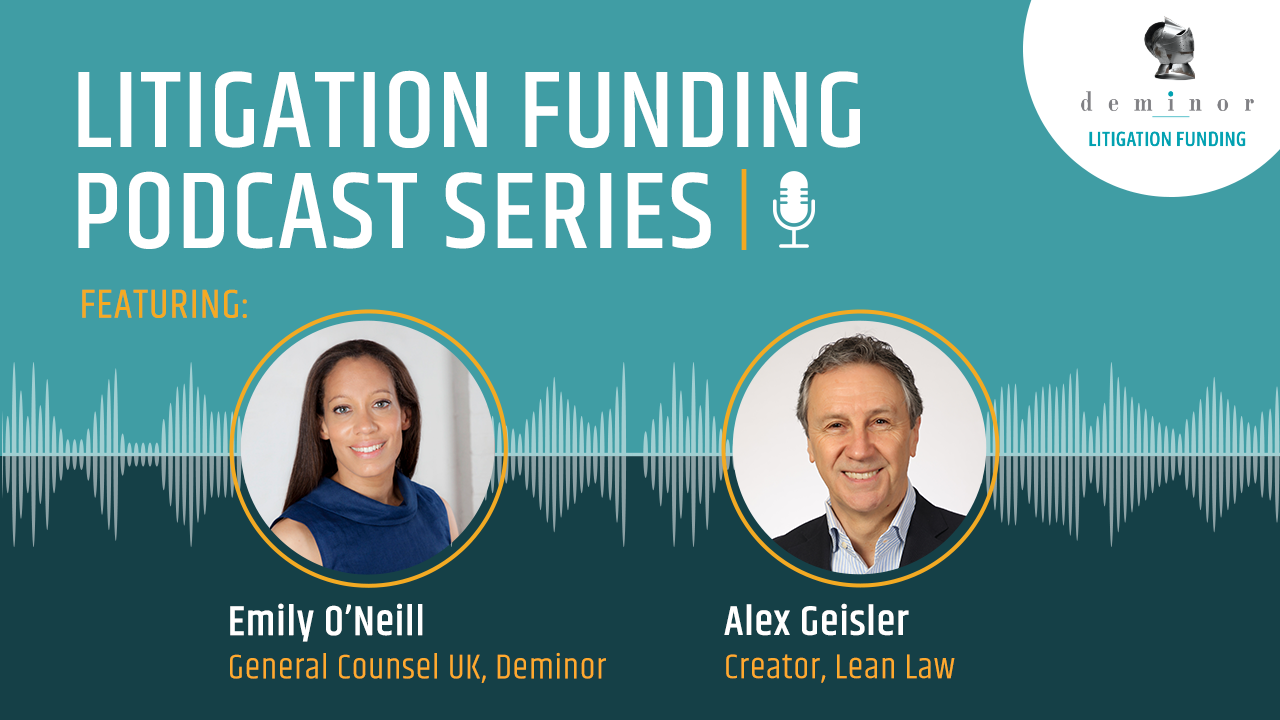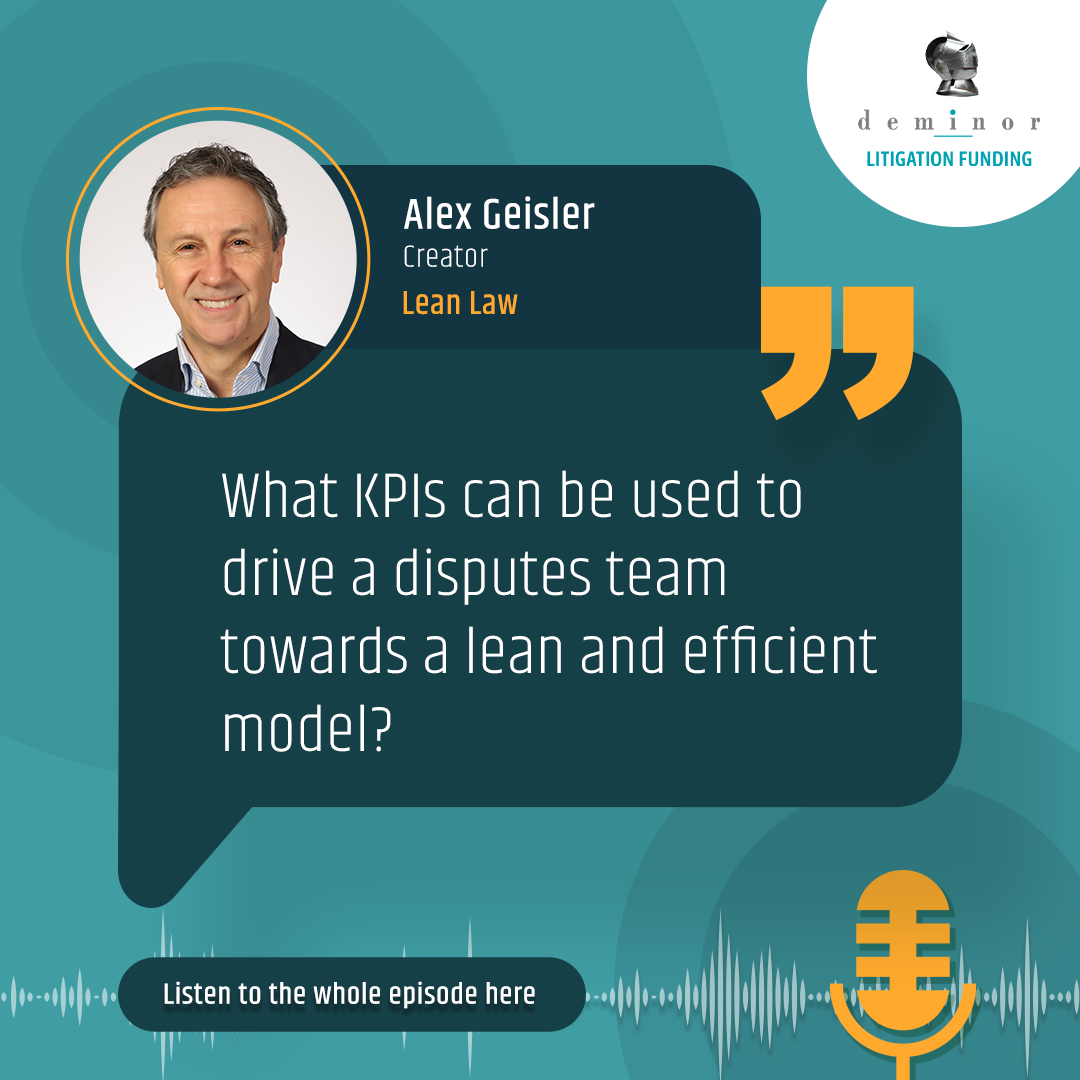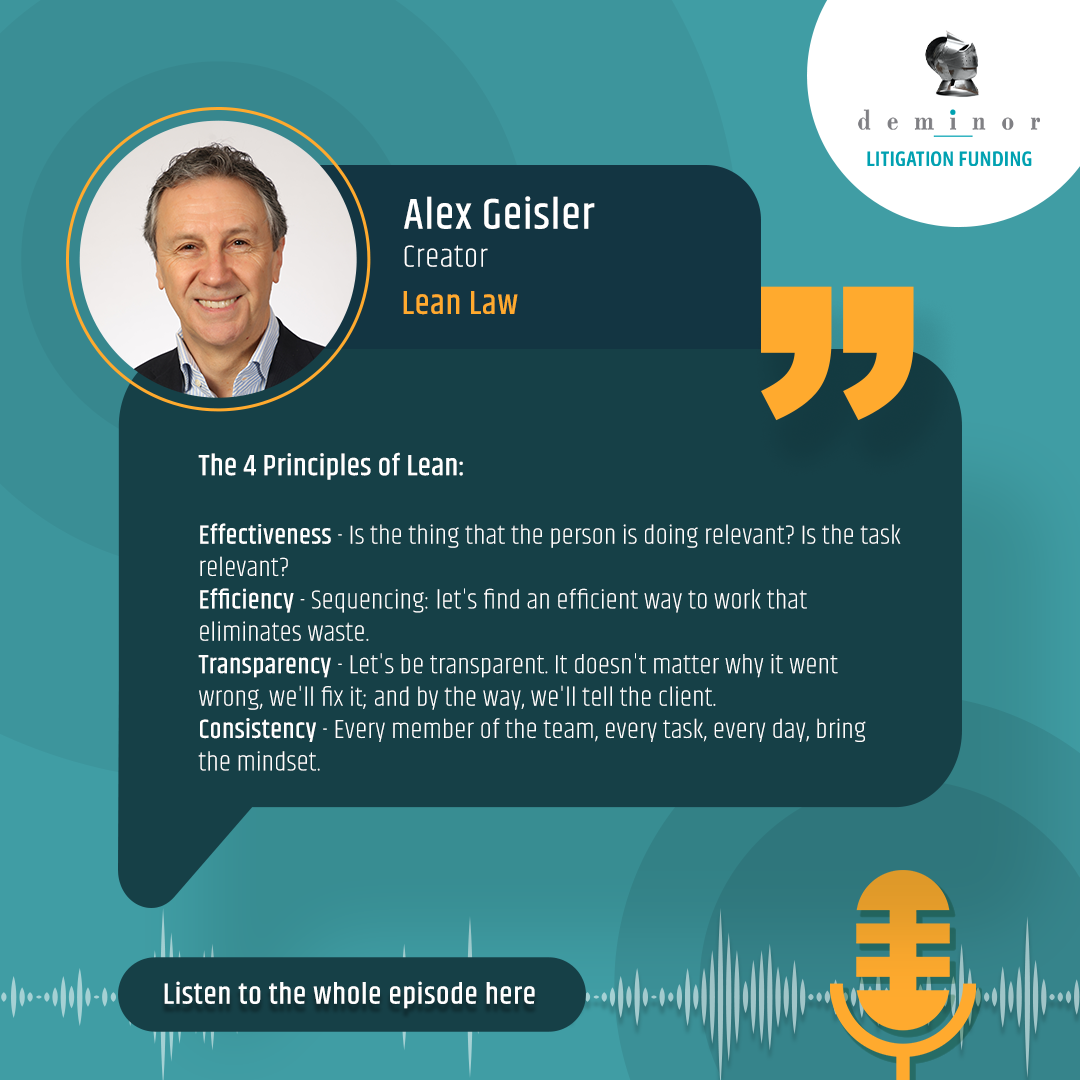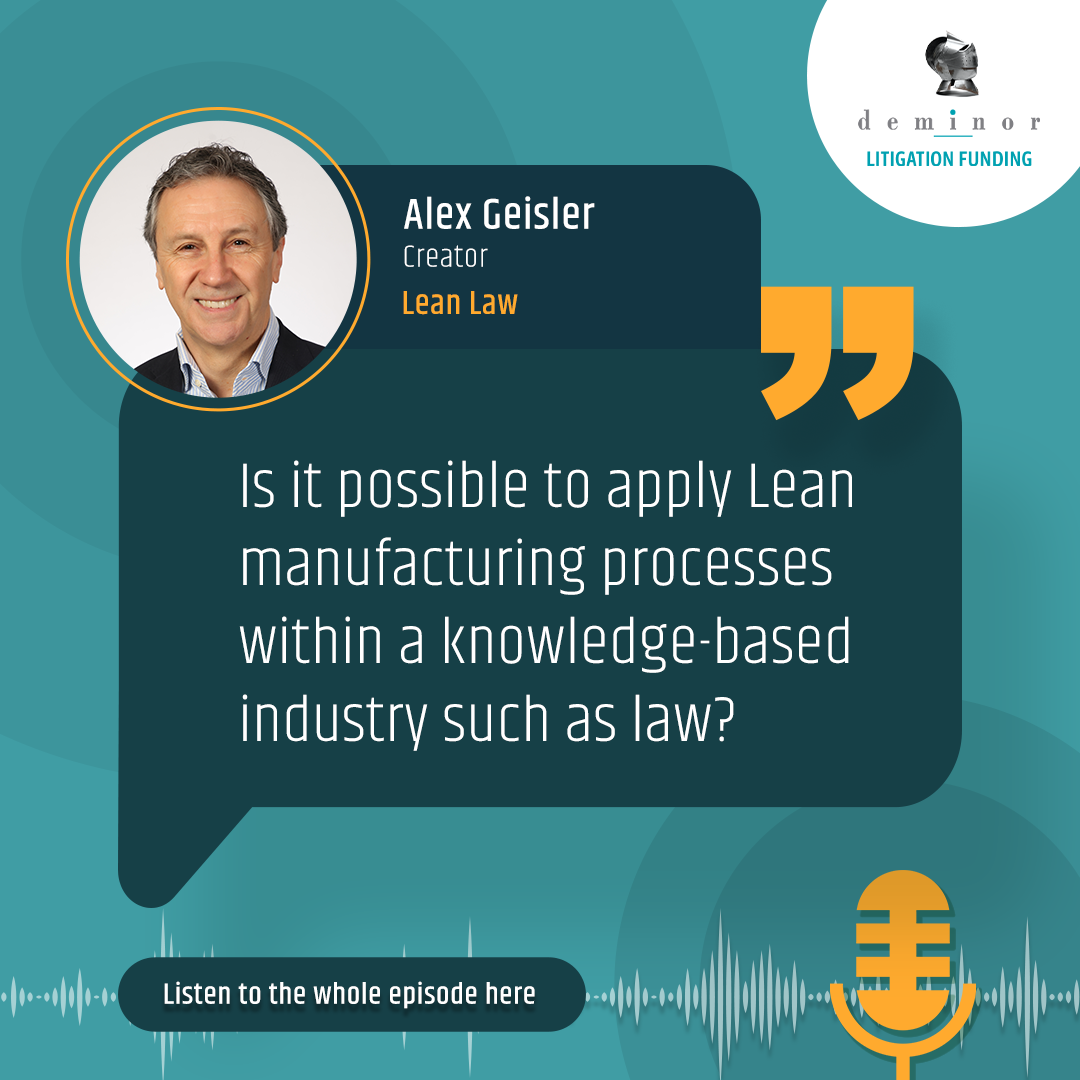In this podcast series, Emily O'Neill General Counsel UK for Deminor Litigation Funding, undertakes interviews with global professionals to discuss different aspects of the litigation funding process. We have already considered the importance of the client in litigation funding as well as the business case for funding.
Deminor welcomes you to join this conversation as we summarise the key elements of the conversations between Emily O'Neill and these experts, as captured in the podcast transcripts below.

Podcast Preface:
Deminor General Counsel UK, Emily O'Neill (EON), speaks with Alex Geisler Creator of Lean law, an organisation which seeks modernise the practise of law by applying the principles of lean to make it client-focused, leaner and more reliable.
In this interview with Emily, Alex introduces the concepts of lean and how they apply to litigating disputes. Companies and funders alike value having clarity and predictability around budget and timelines as much as possible, and Alex considers how lean techniques can support that goal.
Podcast Transcript:
EON – What are the principles of LEAN?
AG – Lean goes all the way back to Henry Ford. And we'll do this super quick because that's Lean, right? Henry Ford looked at all these people in his factory in 1910 – one person was tightening some wheel nuts, then sewing a seat, and then doing something else. Henry thought this was super inefficient: people were wandering everywhere, and they were all trained to do everything. What if people specialised and somebody said, ‘But the job would be really dull?' Henry replied, ‘It doesn't matter; the cars will be cheaper, and I'll pay them more. In fact, they could be my first customers.’ And so he started to organise how manufacturing could work in a more structured way.
Then along came Toyota in the 1950s, and they really elevated the whole thing. They said, ‘Let's have some goals around this, some KPIs, highest quality, lowest cost, shortest lead time.’ Aren't those awesome for dispute teams, right? Highest quality, lowest cost, shortest lead time. Toyota thought those were great KPIs and great goals. How are we going to do it? They applied some attributes which were, again, very intentional and very specific:
Effectiveness. Is the thing that the person is doing relevant? Put it into a dispute context: You can always find stuff to do, but is it relevant? Do you really understand what the client's goals are? And is this particular task-relevant? Why are we doing it? Or why are we having two partners do it? Maybe it's peripheral; maybe an associate could do it, and we could have a sidebar. So, effectiveness means, is the task relevant?
The second one was efficiency. Find waste in the process. That's now true everywhere in manufacturing. It's also true in kitchens, if you watch that fun Chicago drama about a kitchen, the Bear, they're all running around. Or that movie The Founder, the same thing, about McDonald's – process: let's find an efficient way to work that eliminates waste. And, particularly for clients, needless drama; they are quite specific about that.
They came up with the idea of sequencing: we do this before we do that. You see it in car factories today: One technician will tighten up the wheel nuts, and then a screen above them will go green, and they'll go to the next one. Then there'll be four-wheel nuts on the wheel, and the whole thing will flash green, and the vehicle will move down one. That's sequencing. That person won't come off and start putting in a glove compartment – It's sequencing. All those steps have to happen before the leather goes in because leather is expensive and it'll get messy. What's the last thing you do? You put the engine in because that's the most expensive thing. And in a factory, the engines arrive about an hour before they're needed. They're so expensive, they arrive every hour. You get engines delivered, and you don't leave them overnight because the cost of inventory of an engine is just too much. So, let's have them arrive during the day. So this whole idea of sequencing, process flow and pull flow, meaning one task is finished, and it leads to the next one. It is incredibly useful for dispute teams once you start to think that way. What’s the last thing you do before a court hearing? Usually, you pull together a schedule of costs. This can be an annoying distraction when you’d like to focus on the arguments. Ideally, you’d get it out of the way sooner, but you don’t have all the data points. This principle can be applied to the entire litigation lifecycle; there is an optimum sequence for every task; it just needs thought and planning.
And the third one was transparency, meaning everybody can see what everybody's doing. No mystique, no spin, let's not blindside the client, and let's not have any unpleasant surprises. So, if something goes wrong, because it's dynamic, stuff always goes wrong – Let's spot it. Let's be transparent. It doesn't matter why it went wrong; we'll fix it, and by the way, we'll tell the client.

When I do sky maps for clients, a reporting tool, they might have a portfolio of similar fact cases. And we'll do a sky map, which is 20 cases, all up in the air, and it's an instant visual of those. Of those 20, 17 are on target, meaning they're in line with strategy; we spent the right amount; it's going the right way. Two are off course, but we've spotted it, we know why they're off course. And the third one is under investigation: something's happened; we don't know why, we're worried about it. Be transparent. Something's gone wrong here. Let's not pretend it didn't happen. Let's not tell the client it didn't happen. Let's not tell ourselves some reassuring narrative that it's probably okay. The one that's not gone well, but we don't know why, let’s pay some special attention to that.
If you can do all three of those, the fourth one is consistency. Do all that consistently. There's no point doing it for part of the assignment and then losing your way. It really is a mindset. Every member of the team, every task, every day, brings the mindset. Let's be efficient, effective, and transparent. Let's all of us do all of it consistently – and that's the key to success right there.

EON – What KPIs can be used to drive a disputes team towards a lean and efficient model?
AG – The KPI, in a macro sense, is the mindset. It's the feeling of operating in a controlled, efficient structure. But specifically in terms of measurables, because you can't really measure a feeling, in a micro sense, I think the most valuable KPIs are always the ones that matter to the client because you can think you're doing a great job, but you don't get the next dispute, so what's the point? And the KPIs that matter to clients are very clear, we get this from GLL (Global Leaders in Law), which is one of the advocates of Lean Law. Corporate Council is another one; they are big advocates of applying Lean to disputes and even to transactions as they have time and budgetary constraints to balance with case outcomes.
What the client sees as KPIs – The main one is outcomes: what does good look like to you? So, the client comes in and says, ‘I'm a farmer and my next door neighbour stole my tractor’. All right, tell me about your business. Why does it matter? What does good look like to you? What is that outcome that's going to be good for you here? The client says, ‘well, it's a disgrace, it's a theft, it's my neighbour’. That's not an outcome. Let's really focus on what's a really good outcome for you and you get the client to say, ‘the harvest is in two weeks. I need corn out of the field and off to market’. Now, we understand, okay, that's an outcome. Now, we can apply the law to the dispute and we can address an outcome because running off and getting an injunction, spending a fortune that takes six months, that's litigation, but it's not outcome facing, it's not client facing. So, the first KPI is what's the outcome? And you only get to that by having a conversation with the client around ‘what does good look like?’
The next one is money. Lawyers are slightly hesitant to ask: ‘What's your investment appetite?’ Maybe it comes from law firm billing pressure. Maybe it comes from some of the terms that law firms use, like fee earner or timekeeper, instead of terms like problem solver. It's kind of the wrong way around; it's all inward-facing. The money issue isn't about what the project will bear. The money issue is around value and investment appetite. And that calls for a conversation with the client and some budgeting. Do some smart budgeting, think about what a good plan would look like; that's robust, that we're doing things in the right order, but it's efficient – We're not spending money in the wrong places; we're staying focused on a good outcome.

It's going to cost, and have that conversation with the client up front. Have a plan, stick to it, make sure you're monitoring cost burn. Then comes accountability, at the end, go back to the client and say ‘there's your KPI’. I said we could do this for X. We went over budget by 12%,’ and the client would say, ‘Yeah, I know. Do you think I didn't notice? Of course, I know.’ Okay, but we told you why, and you saw in real time that we had to do two extra things, and you greenlit that. We had to go to Brussels to read some documents. That was out of scope, but you asked us to do it. The client says, ‘I know. That's the 12%, I've got it.’ And it's all transparent, which is a big theme: accountability.
Money is always a KPI. Unless it's a Bet the Farm case, but you get one of those per career really.
The third KPI is client resources, and it's undervalued. You say to the client: ‘According to my plan, which I'm asking you to support, I'm going to need you, the MD, for several half days. I'm going to need your time. I'm going to need your chief accountant and chief engineer for the trial. If we get to trial, I'm going to need three days prep for your chief engineer. I'm going to need you in court for a week in London or New York, wherever it is. This is the resource commitment I'm asking you for. So don't be shocked when I say to you, look, we've agreed on a court date of February 2025. I need you in London for a week. If that's going to be a problem, let's know about it now, because I will need you there. Or there's a mediation, and I need you there. It's a resource. I don't want you dialling in. I want you to show up and be there. I want you to come to the prep meeting. I want you to support the strategy. That's your time. And I get it, and I get that you're busy, but it's a resource. So, are you committed to this or not?’
And some clients will say, ‘Got it, I'm behind you’. And others will say, ‘I don't remember why we're suing them?’ ‘We don't do business with them anymore; we've got a new supplier/trading partner.’ ‘We've written it off. Nobody cares.’ ‘No, I'm not going to spend a week in London. I'm doing a launch/acquisition.’ So real transparency and planning around resources that's your third KPI.
![]()
Fourth is lawyer time, which is connected to money. How much lawyer time are we going to spend on this? Are we going to spend it smartly? Is it the right lawyer doing the right task? Are we going to have two partners sending each other emails and charging the client for it? Are we going to have sidebar meetings with two partners? Two associates? Is there a value to it? If there's a value to it, that's fine. That's four lawyer hours. It might be creative work. It might be a problem-solving issue. It might be a crisis thing. It might be a check-in. It might be a planned check-in once every three months, and budget for it. It's time. Let's just not wander into lost lawyer time because it's a KPI.
And the last one (five) is comfort. Is the whole client experience a comfortable journey? You see people walking down the steps of the High Court in the Strand; even though they've won, they say, ‘Never put me through that again. I'm totally traumatised.’ or ‘We won, but it's destroyed by life. I never ever want to go through that again.’ And that's not necessary. It doesn't have to be that way.
The journey doesn't have to be full of drama. It's like flying – you're going to New York, paying British Airways a certain amount of money to get you there for a reasonable fare, using a day of your time in a level of comfort, no drama. You don't want to walk through JFK traumatised going that was horrible. It's not necessary.
These are the main 5 KPIs that I'd suggest dispute teams look at in terms of managing and streamlining.
EON – Some of those really resonate from a funding point of view. Clients and resources. We look a lot around the budget and law firm resourcing. But if the client doesn't have the resources to support the case, it's not going to be a good case.
I think the second part is business strategy. Business strategy kind of moves more quickly sometimes than litigation does. You were talking about ‘Will you be available in January 2025 for a one-week trial?’ But in my experience, executives move around quite quickly. So, three to five years, they're in and then out of a business and having the right people remain there to be a resource for the litigation is also, from our side, quite important. A lot of those points resonated.

EON – Let’s look at a case study now, can you talk through in detail a process a disputes team have tackled and streamlined within a case or within their business applying lean techniques.
AG – Again, you can take streamlining end-to-end, or you can take it in a micro sense in parts of the challenge that disputes teams face. An easy place to look at this is documents. How can you streamline documents? And this is the old ‘documents’ or ‘people’, ‘what I do first?’
There are disputes teams who will say: ‘let's read everything. The client sent us everything, and we need the fees and there's lots of us and we're all timekeepers, so let's all of us read everything even though, as we all know, 90% of everything is irrelevant.’ It's always 90% - best case, 90% of it is irrelevant. So that's one method; reading everything is not just inefficient, it's not allied to effectiveness. Because you don't know what you're looking for and you will miss stuff. You'll only have to read it again once you've found out what the case is about.
Then there's the other end of the spectrum, which is let's go and interview the client: let's spend two days with the client. I don't mind that as much. We'll interview the key fact holder. The key fact-holders say: ‘This is what happened; here's the history.’ But at times, the key fact holder will say: ‘Why am I telling you? Do you not know what this project is about? Why do you guys not know what this case is about? Have you not read anything?

A lean process is to park all the documents, and the fact holders and say to the client: ‘Can somebody who knows about this give us a 1-hour overview and point to the ten key documents?’ Because if you want us to get from A to B real quick and save you some money and get us oriented with this, you're going to have to do some work otherwise it's going to be way more expensive. So, can somebody give us a reasonably reliable potted history of what this is about? why it matters? what does good look like? why we are where we are? and a guide to the Ten Key Documents – it might only be one key document, it might be a contract. Then we’ll go from there; we won’t read anything else yet and work from there outwards.
They've then identified the key fact holder and identified the key documents. Then, you would look at the key documents, formulate some structured questions, and get some sense of what the history is and what a litigation plan and a case plan could be. And then you build it. It looks like more steps. Read it all then interviewing everyone is two steps, but it takes weeks, is massively inefficient, and you don't learn much. Whereas lots of smaller steps is way more efficient. It's a classic lean process; it's structured, and it's streamlined. ‘Do this before you do that. Plan it. How are we going to do it? What should we do first?’ Rather than just dive in.
Google ‘Project Management’, it says: ‘plan, execute, monitor, improve’ – it’s not complicated; that's what we're talking about. Don't just dive into execution: Interviewing witnesses, reading Discovery… Plan, meaning: stand back from it, sequence it, understand what good looks like, survey it, look at your resources’ think about a good process, and then you get to execution.
One example is price predictability. A client will send something out to an RFP, and there are firms who will say: ‘What will it bear? We like this piece of work. It's a repapering a subordinated loan note / or suing an ICI… Yeah, we'd like this. What will it bear? How are we going to price it? What will it bear? The client wants price predictability. What will it bear?’ Completely wrong question.
The other end of the spectrum, you get is, ‘let's undercut it to win it. Let's just undercut everybody else. We know it's probably gone to three Silver Circle firms. They're going to charge between X and Y. Let's take 40% off that. We’ll get this job because we need the work.’ You might get the job, but how's that going to end? You're going to go way over budget, and you'll commit the cardinal sin of upsetting the general counsel, who has been to the business and said, ‘I've got a law firm do this for X.’. So the GC gets a budget for X, gives it to you, and you don’t get anywhere near the price. And the QC thinks, ‘I should have gone to a Magic Circle firm or a Silver Circle firm, even though they're all 40%, dearer’

They're both wrong. The better way is to budget it properly. Yes, of course, put some contingency in, but not 15 caveats. In the first days of CCMCs, you had to cross budgets – There's a thing that went around the city with the 20 best caveats, and people used to cut and paste it. That's not great either because there's no price predictability in that. So, plan it properly; work out what the tasks are - are they relevant? What's the order of priority? Who would do each task? Where's the redundancy in this?
In other words, is somebody checking if we've got juniors doing first-level doc reviews, or have we got technology doing doc reviews? Where's the redundancy? Where's the fallback? Where's the creativity piece? Have we created any space in all of this for creativity and horizon gazing? Then, price it properly and put in a contingency. You can tell the client we might be out by 12% to 15%, and of course, it's event-driven, but this should be close. If it comes out dearer than everybody else and you don't get the job, somebody is going to undercut it and lose. There's a bit of integrity around this. That's what we can do this for, and we'll be accountable if we don't. If somebody wants to undercut us, good luck. Let’s see how it works out for you.
EON – In my role, I see the opposite. I see funder budgets. I was a GC in a manufacturing company before I came here. I know how much litigation costs in the US or Europe, and now I see different budgets that don't really align with the budgets that I used to see. Price predictability is key, but I think it's transparency and having a budget that's actually realistic because funding is an expensive source of capital. And if the budget is higher than the expectation, that has a direct impact on the client and what they take home, so it’s also bearing that in mind.

EON – If I wanted to start on this process, what would be the first steps that I would need to take? Where do you start with Lean?
AG – That's a great question. The work I did was through decades of working with manufacturers. I took the lean methods and modified them for professional practice, for law as a service.
I was having this conversation with Ian Jeffery, CEO of The Law Society, at your dinner a couple of weeks ago, and he said: ‘How do you modify manufacturing processes for a knowledge-based industry?’ And we got into how we did it. And he said, ‘No, I know, you're right.’ And then we got into that a little bit… but the essential premise is right that it needed modifying. I took each lean attribute and method, modified it, and put it into a playbook, which I then called Lean Law because it was a snappy title. Lean Law is now accessible in a variety of ways.
The best thing to do is go and get Lean accredited. It's a course that's run by American Legal Media. It's an online course, and it's sort of 20 years of missing mentoring, everything you need that you could take 20 years of trial and error to learn.
And for disputes teams, not even the whole team, just one member of the disputes team (normally an associate), will tend to go and get Lean accredited. And it's relatively cheap. They then get the Lean accreditation and the LinkedIn badge that goes with it. Lawyers love to put LinkedIn badges on their social media. They put it on their firm bio, and that person will be the Lean project manager within the disputes team and do everything we've been talking about. That's the best place to start. Absent that another way is I've got a book called A Letter From Your Client, which is the sort of client's prayer, which is, again, very short, and it's everything your clients want from you to practise successfully.

Litigation Funding Podcast Series - Next Steps and Further Information:
Thanks for joining Deminor's Litigation Funding Podcast Series as we dive deep into core topics in funding litigation.
Keep an eye out for our upcoming conversations as Deminor General Counsel UK, Emily O'Neill, speaks with several more experts to get their insights into different aspects of litigation funding.
If you would like to connect with either Emily or Alex on LinkedIn, please click on the links below:
Emily O'Neill – Deminor General Counsel UK and Global IP lead
Alex Geisler – Creator, Lean Law
***
Further Reading:
- https://www.deminor.com/en/case-studies/co-funder-proposes-sharing-of-litigation-funding-risk-to-leverage-deminors-in-house-due-diligence-capability
- https://www.deminor.com/en/case-studies/financing-assertion-of-patents-protecting-manufacturing-processes
- https://www.deminor.com/en/case-studies/telecoms-patent-assertion-multi-jurisdictional-campaigns
- https://www.deminor.com/en/case-studies/canadian-innovative-start-up-preparing-for-a-david-v-goliath-litigation-funding-battle
- https://www.deminor.com/en/case-studies/whats-the-risk-assessing-the-risk-of-counter-assertion-by-the-defendant-in-patent-litigation
- https://www.deminor.com/en/case-studies/overstepping-the-mark-litigation-funding-trade-mark-infringement
- https://www.deminor.com/en/case-studies/lights-camera-action-recovering-damages-for-infringement-of-rights-in-a-short-film
- https://www.deminor.com/en/case-studies/recovering-damages-for-stolen-software-through-litigation-funding
- https://www.deminor.com/en/case-studies/funding-in-the-pharma-sector-/-investing-in-a-case-where-litigation-is-already-ongoing






